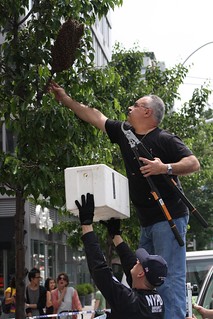Before Bee Week concludes here on The Local, we should mention that Timothy O’Neal, the beekeeper who tends to the bees on the rooftop of the 308 Bowery, got back to us today to tell us why exactly he thinks the bees that swarmed near Bleecker Street on Wednesday likely came from a neighboring hive rather than those belonging to Bowery Poetry Club owner Bob Holman.
According to the beekeeper, swarms don’t leave a hive until developing queens are properly nursed and are a day or two from emerging as adults. “When I inspected his hives, I found signs that they were preparing to swarm by creating queen cells, but that they were not far enough along for the swarm to have departed, and the population density was very high,” Mr. O’Neal wrote in an e-mail to The Local.
Mr. O’Neal, creator of the Borough Bees blog and co-founder of the Big Apple Apiary, also took issue with an assertion made by Andrew Cote, the beekeeper who dealt with the swarm on Wednesday: his hypothesis that the bees might have swarmed due to the Bowery Poetry Club’s use of a top bar hive was “a gross oversimplification bordering on dishonesty,” said Mr. O’Neal. Safe to say he was stung by the allegations.
The beekeeper insisted that the management and swarm suppression techniques used for Langstroth hives could also be employed with top bar hives, though few beekeepers realize it. “Some are just ignorant,” he said. “Others are aware, but choose to ignore styles of beekeeping that differ from their own for reasons unknown. Maybe a top bar hive dumped them once?”
“When managed properly, top bar hives can be just as healthy (or more so, according to some) as any other style of hive and equally unlikely to [cause a] swarm,” he insisted, adding that no form of hive could completely suppress the bees’ natural urge to propagate their species.
We’ll leave that debate to the experts. The weekend has arrived, so if you don’t mind, we’re going to go get our buzz on.




